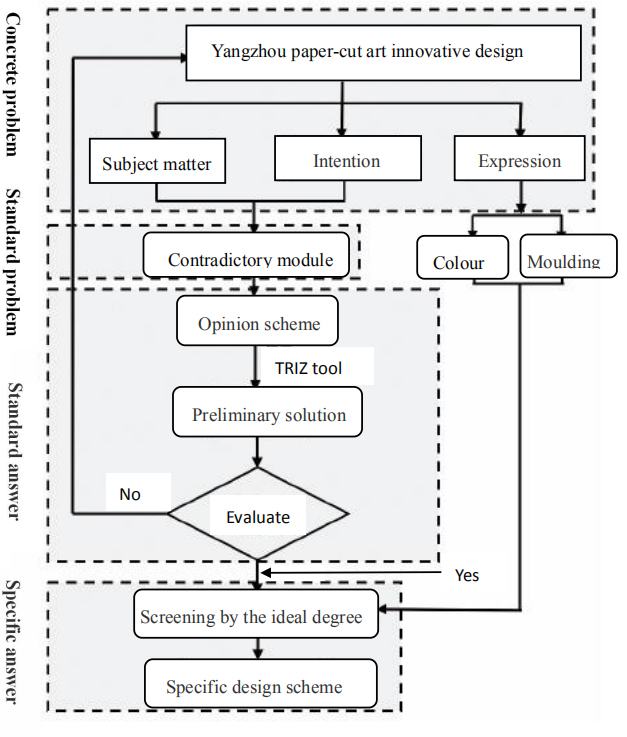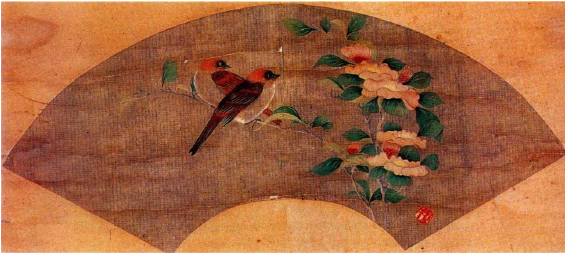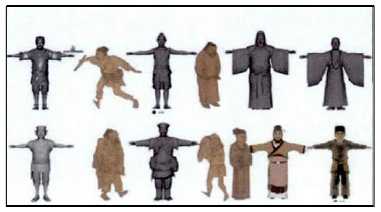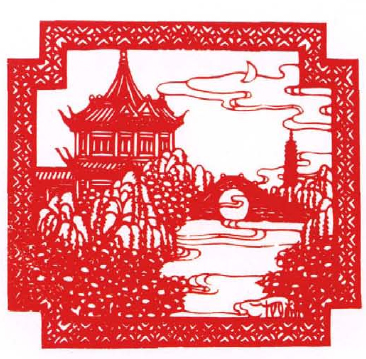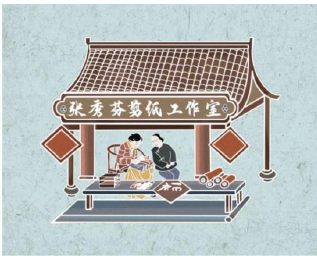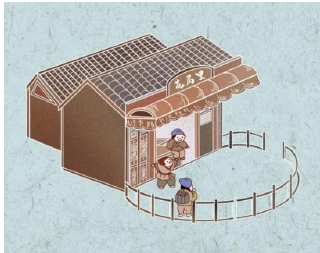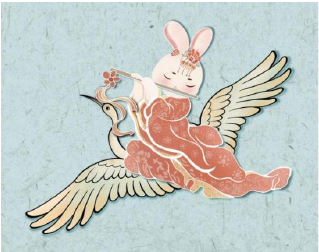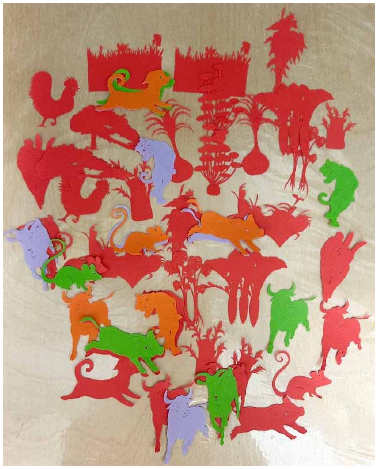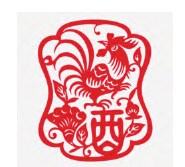1. Introduction
2. Introduction of TRIZ Theory
3. Characteristics of Yangzhou Paper-cut Art
3.1 Diversified themes
3.2 Unique Choice of Image
3.3 Diverse Methods of Expression
4. The Application of TRIZ Theory in the Innovative Design of Yangzhou Paper-cut Art
5. Conclusion
1. Introduction
As an intangible cultural heritage, Yangzhou paper-cut1-2)has strong regional cultural characteristics and contains rich traditional culture and connotation. Yangzhou paper-cut art has a wide range of applications in modern industry, which can be applied in the fields of clothing, packaging, gift design, etc., and is popular among the public. Therefore, the cultural and creative products based on Yangzhou paper-cut art have a broad development prospect. In order to make traditional non-heritage material and cultural heritage better serve the social and economic development, many scholars have tried to apply modern product design theories to various aspects of cultural and creative product design. Among them, the design theories or methods3,4,5) with more applications are emotional design theory, semiotics theory, shape grammar, and so on. However, the theoretical application of traditional paper-cut cultural and creative product design is mostly concentrated in the extraction of cultural elements and redesign process, while the application of theories in the function and category innovation of cultural and creative products is less. Against this background, to change the stereotypical impression that many consumers have of the current cultural and creative products as “old-fashioned” and “impractical”, the TRIZ (Theory of Inventive Problem Solving)6,7,8,9,10), which was born in the field of engineering design, has gradually begun to appear in the vision of researchers of non- heritage material culture cultural and creative product design. This paper summarizes Yangzhou paper-cut, combines modern visual communication design elements with the artistic characteristics of Yangzhou paper-cut, and innovatively design based on TRIZ theory so as to make it more in line with the aesthetics of modern people and enable Yangzhou paper-cut to be better inherited and developed.
2. Introduction of TRIZ Theory
TRIZ (Theory of Inventive Problem Solving (TIPS))11) is a theory of innovation - a theory for solving the problem of invention and creation-proposed by the famous G.S. Altshuller of the former Soviet Union. On the basis of analyzing more than 2.5 million patents in the world, the theory summarizes the rules that should be followed in technological evolution as well as the theory of invention and innovation to solve various engineering contradictions. The theoretical system mainly includes the following aspects: (1) situational analysis and description method of invention problems; (2) law of technological system evolution; (3) invention of 40 theories of solving problems; (4) substance-field analysis model and invention problem solution; (5) idealization and ideal design; and (6) invent the problem-solving algorithm ARIZ (Algorithm for Inventive problem Solving).
S. Altshuller12) found that similar problems alternate in different industrial and scientific fields. The mode of technological system evolution appears alternately in different engineering and scientific fields, and the scientific principles on which innovation is based often belong to other fields. The TRIZ theory suggests that different inventions tend to follow common and few theories, laws or rules. Finally, after analyzing, organizing and summarizing, 40 theories of invention and creation and 11 separation theories used to realize innovation are sorted out. For specific conflicts, solutions can be sought based on these theories of invention and innovation. Therefore, the innovative design principles followed in the innovative design of Yangzhou paper-cut art are not necessarily all from the non-heritage folk material culture and art creation industry. It also can skillfully use the characteristics of other industries and innovative design principles to create more innovative Yangzhou artistic works. As a result, TRIZ theory can make the direction of Yangzhou paper-cut art more clear and can contribute to its development. The innovative design of Yangzhou paper-cut art combined with TRIZ process has stronger applicability, and its specific flowchart is shown in Fig. 1.
3. Characteristics of Yangzhou Paper-cut Art13,14,15)
3.1 Diversified themes
The content of Yangzhou paper-cut13) is closely related to the life of the working people, mainly flowers, birds, fishes and insects which are popular among the working people, supplemented by figures, animals, auspicious patterns, scenic spots, etc. The content implies good luck, happiness and well-being. Yangzhou paper-cut is greatly influenced by Chinese flower and bird paintings, with a strong flavor of literati paintings, and its style tends to be as fine and elegant as literati paintings. Common Yangzhou paper-cut patterns are shown in Figs. 2, 3, 4.
3.2 Unique Choice of Image
In terms of modeling, Yangzhou paper-cut uses flat paper as the modeling material, with lines and surfaces as the basic modeling symbols. It abstracts the concrete images of the objective world into different compositions, and then displays the three-dimensional visual effects with two-dimensional creation techniques. In this way, the finished paper-cut products are made with perspectivity. For example, in Fig. 5, “Dongguan Street on Yangzhou Canal”14), this paper-cut adopts the horizontal scroll type in composition, and selects scene props, characters, plants and animals, and other elements for the construction of the picture in the character design. With scattered perspective, the houses, figures, IP image of the Year of the Rabbit, and the landscape are organically integrated into the same picture, highlighting the bustling market scene of Dongguan Street on Yangzhou canal. The use of color imagery in Yangzhou paper-cut is very subjective and often does not use the true colors of the objects depicted. The general use of color can be divided into two categories: monochrome and suite of colors, the former with red and white as the main color, while the latter with one kind of hue as the main content. It emphasizes less and refined color in use, focuses on the contrast and coordination of colors, and enhances the sense of hierarchy and decorative sense.
3.3 Diverse Methods of Expression
Yangzhou paper-cut techniques are very diverse. Most Yangzhou folk paper-cut artists15) are excel at fresh, fine, and smooth lines. Its techniques can be summarized as pointed, round, square, lack, line, with the point as wheat, pine needles; round as the autumn moon, a jade plate; square as a brick; lack of jagged teeth; line as the immortals’ beard, whisking in nature. However, some paper-cuts of folk artists feature with fine and neat composition, vivid and interesting depiction. They prefer to use deformation and exaggeration techniques to combine the whole and the scattered, the dense and the sparse, the real and the imaginary, and to make it static in motion. With whichever expression techniques, Yangzhou paper-cut owns its local feature, containing a profound cultural connotation and aesthetic value.
4. The Application of TRIZ Theory in the Innovative Design of Yangzhou Paper-cut Art
Yangzhou paper-cut is still dominated by traditional folk paper-cut, and innovative works are scarce. As an intangible cultural heritage, Yangzhou paper-cut needs to be constantly innovated with the development of the times in order to be better inherited and developed. In the innovative design of Yangzhou paper-cut art, the creation of image, the connection between images and the formal law of beauty can be designed by applying the 40 invention theories in the TRIZ theory to design art works. With 40 theories of invention, the design program can have more creative inspiration and the regularity of creativity.
From the 40 theories of invention and creation, 18 of them are identified as representative theories for application in Yangzhou art and innovation design. Several Yangzhou paper-cut design creative solutions are obtained after combination. The following are the selected 18 theories: (1) segmentation theory; (2) separation theory; (3) merging theory; (4) nested composition theory; (5) dynamic theory; (6) dimensional change theory; (7) periodic action theory; (8) change of color; (9) asymmetry theory; (10) curved surface theory; (11) inversion theory; (12) replication theory; (13) state change theory; (14) porous material theory; (15) hypervelocity action theory; (16) mediator; and (17) local mass theory; (18) continuity of effective action. According to the permutation theory, the above 18 theories can be combined into a variety of programs. Some representative combinations are extracted from these programs.
The analysis of the above 18 theories can be summarized into the following categories: (1) with the characteristics of the movement nature: dynamic theory; the periodic action theory; the theory of ultra-high-speed action; the continuity of effective action; (2) with the characteristics of the space nature: the dimensional change theory; inversion theory; nested composition theory; (3) with the characteristics of the structural changes: curved surface theory; asymmetry theory; replication theory; porous material theory; (4) with the characteristics of aggregation and dispersion: segmentation theory; separation theory; merging theory; (5) with other special properties: change of state; change of color; mediator; local mass theory. In these five categories, the theories in each category can be combined with each other, so do the theories between categories. It can be a single theory or a combination of multiple theories. The combinations form different design solutions, making the work more expressive. The following are examples of the application of the various combinations listed below:
By combining the dynamic theory with the characteristics of movement nature and the change of color with other special properties, as shown in Fig. 6, by gathering the dynamic characters together and changing the color of the lower body, it will produce an attractive and strong visual effect psychologically. This visual effect plays an important role in the composition of advertising design.
By combining the dimensional change theory in the characteristics of spatial properties and the local mass theory in the characteristics of other special properties, as shown in Fig. 7, the picture of the three children and the fence are extended outward from the two-dimensional graph of the house. This figure has a strong ability to change, exerting a strong visual impact.
By combining the hypervelocity action theory, which is characterized by the nature of motion, and the curved surface theory with structural changes: as shown in Fig. 8, the tilted red rabbit sits on the flying white bird, with the feeling of leaping and moving forward. The front and back are opposite to each other with a sense of flying.
By combining the local mass theory with other special properties and the replication theory with structural changes, as shown in Fig. 9, the graphics are locally detailed and contrast with each other. At the same time, all the cloud graphics are replicated and unified. The sense of unity is strong.
By combining the porous material theory with the replication theory in the characteristics of structural change, as shown in Fig. 10, the holes in the door and window parts of a house have the effect of points, which can easily produce a sense of space. This theory is widely used in packaging design.
By combining the state change theory and the periodic action theory among the characteristics with other special properties, as shown in Fig. 11, the animal pattern rotating from the inner to the outer center has a dynamic change that extends outward. The periodic movement forms a vortex shape. It has a strong sense of order and beauty.
By combining the merger theory, which is characterized by the nature of aggregation and dispersion, and the replication theory with structural changes, as shown in Fig. 12. The color matching method such as set color, bucket color and spot color in paper-cut is designed, supplemented by calligraphy and painting, so that the packaging as a whole presents a lively and vivid effect.
By combining the segmentation theory with the characteristics of aggregation and dispersion and the merging theory with the characteristics of aggregation and dispersion, as shown in Fig. 13, the paper-cut appearance of the base adopts the segmentation principle, forming a varied texture and enriching the content of the work. Combined with the bottle cap, it forms a complete work of art.
5. Conclusion
As a unique intangible cultural heritage handicraft, Yangzhou paper-cut plays an important role in inheriting national culture and continuing historical context. Its innovative design can boost the development of Yangzhou paper-cut art. The application of the theory of invention and creation in TRIZ can make the innovation of Yangzhou paper-cut art design procedural and theoretical with its good operability, systematicness and practicability. The appropriate combination can be selected according to the final required effect (such as dynamic effect) of the design. Furthermore, this paper provides a theoretical basis for the realization of intelligent computer aided technology in Yangzhou paper-cut art design.



